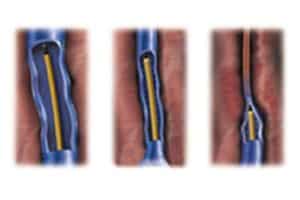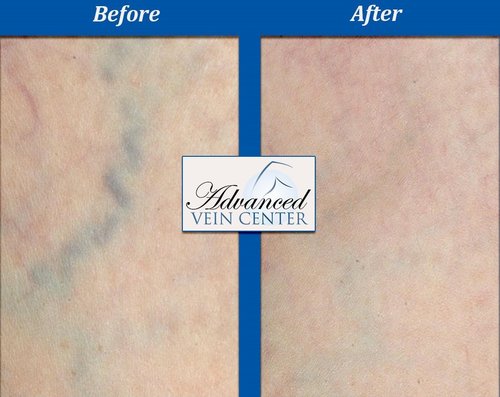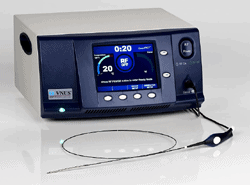VNUS Radiofrequency (RF) Ablation
In recent years several new, minimally invasive treatments have come to dominate the treatment of vein disease of the legs. As a class of procedures they’re more efficient, effective, and share almost none of the drawbacks of traditional vein stripping. VNUS Radiofrequency (RF) Ablation has established an impressive track record of safety, and involves very little recovery time.
The VNUS® RF Ablation system, also known as the Closure® technique, is now extensively use. It’s designed for safety, ease of use, and has delivered hundreds of thousands of successful treatments to date. As with all RF systems, it relies on radiofrequency energy to collapse diseased veins. Blood is immediately rerouted to nearby healthy veins, and overall circulation is improved. In a matter of weeks, the treated veins are reabsorbed into the body via the natural healing process.
The VNUS ClosureFAST Catheter available in Pittsburgh

Our Board Certified Vein Surgeons are always “one step ahead” in the treatment of vein disease. After evaluating EVLT, endovenous laser treatment, versus RF vein ablation, our physicians found that although both EVLT and Closure RF ablation had similar efficacy in double blind randomized studies (over 95%). Patient satisfaction was higher after Radio Frequency vein ablation, likely due to RF closure vein procedures having less bruising and tenderness than similar laser vein surgery.
The ClosureFAST catheter is designed to significantly reduce procedure time and enhance ease-of-use for the physician, making it the most comfortable vein treatment available for our patients. The ClosureFAST catheter uses Radio Frequency energy and VNUS RF generators to deliver controlled energy and monitor treatment temperature for the purpose of gently closing diseased veins.
The ClosureFAST procedure is performed comfortably in the office. With the help of ultrasound guidance, your physician will position the Closure catheter into the diseased vein. The tiny catheter delivers radiofrequency (RF) energy to the vein wall. As the RF energy is delivered and the catheter is withdrawn, the vein wall is heated, causing the collagen in the wall to shrink and the vein to close.

Highlights of the VNUS Closure® Procedure
- Only local anesthesia needed
- Relief of vein symptoms
- Office based vein procedure
- Resume normal activity within a day of your vein treatment
- Good cosmetic vein procedure outcome with minimal to no scarring, bruising or swelling
What is the difference between radiofrequency ablation, endovenous laser therapy, and sclerotherapy?

Several procedures are used to treat varicose veins. These occur when the valves or walls of the vein don’t work properly, which allows blood to collect or pool in the veins in the leg. This gives varicose veins their characteristic swollen or twisted look.
The following treatments for varicose veins work by damaging the inside of the vein so that it closes and forms scar tissue.
These treatments differ in how this is achieved:
- Endovenous radiofrequency ablation: a catheter is inserted into the vein through a small incision in the skin. The tip of the radiofrequency device heats the inside of the vein, which causes it to collapse
- Endovenous laser therapy uses a thin laser fiber inserted into a vein through a catheter to heat and collapse the vein.
- Sclerotherapy uses a special liquid that is injected into the vein that irritates the vein and causes it to form scar tissue and eventually fade away.
How will I know if I’m a good candidate for radiofrequency ablation?
You’ll need to consult with a vein specialist for an in-depth assessment of your situation. It’s entirely possible that your problems aren’t vein related. Similarly, your vein problems may be limited to the surface and a more superficial treatment is best. In many cases both an ablation technique and surface treatments are necessary.
Another consideration is cost. It’s important to determine whether or not your insurance plan covers ablation procedures. Our staff is happy to contact your insurance company to determine which procedures are covered by your plan.
Are there any limitations or restrictions on physical activity following venous radiofrequency ablation?
Following venous radiofrequency ablation (RFA), there may be certain limitations or restrictions on physical activity. While specific recommendations may vary depending on the individual case and the advice of the healthcare provider, here are some general guidelines:
1. Walking:
Walking is typically encouraged immediately after the procedure to promote blood circulation and prevent blood clots. It is often recommended as a low-impact activity to resume soon after the procedure.
2. Strenuous Exercise:
Strenuous exercises, such as heavy lifting, vigorous workouts, or high-impact activities, may need to be avoided for a certain period. This is to allow the treated veins to heal and minimize the risk of complications.
3. Gradual Return to Activity:
It’s common for healthcare providers to advise a gradual return to regular physical activities. Initially, light activities and gradually increasing intensity can be recommended over time.
4. Avoid Prolonged Sitting or Standing:
Prolonged sitting or standing can strain the veins and impede blood circulation. It is often recommended to avoid long periods of immobility and, if necessary, take breaks to move and stretch.
5. Compression Garments:
Wearing compression stockings or garments may be advised after the procedure. These garments help support the veins, promote circulation, and reduce swelling.
How long does the venous radiofrequency ablation procedure typically take?
The venous radiofrequency ablation (RFA) procedure typically takes approximately 30 to 60 minutes to complete. However, the actual duration may vary based on factors such as the number and size of veins being treated, the complexity of the condition, and the individual patient’s specific circumstances. The duration of the venous radiofrequency ablation procedure can be influenced by factors such as patient cooperation, vein accessibility, and the need for additional interventions during the procedure. It is important to consult with the healthcare provider performing the procedure for a more accurate estimate based on your specific case.
RF vs EVLT vs Vein Glue
Currently three main technologies have come to the forefront. The first is Radiofrequency (RF) ablation, usually referred to simply as RF or RF ablation. In terms of vein disease, “ablation” means “to close down” or “to collapse.” The second is Endovenous Laser Treatment, usually referred to as EVLT or laser ablation. It’s the second main ablation technique in wide use today. The third technique uses surgical grade adhesive to permanently seal diseased veins shut. This type of treatment is informally known as “vein glue.” While this may sound unsafe, the adhesives used are exactly the same as those used in brain surgery.
VNUS Radiofrequency (RF) Ablation Procedure
To begin, Doppler ultrasound, which excels at imaging blood vessels, is used to map out a patient’s leg veins. Since Doppler is capable of measuring blood flow it’s able to pinpoint exactly which veins need treatment. Once this is done, a thin, flexible catheter with a heating element at the tip is inserted into the vein. Electricity is then run through the catheter. This is immediately converted into Radiofrequency energy which produces highly focused heat at whatever intensity the surgeon requires.

When this heat is delivered it causes the proteins which make up the vein walls to contract and collapse. As the catheter is slowly withdrawn the vein closes behind it, sealing it shut along its entire length. In medical terms this process is known as ablation. As mentioned, blood flow is rerouted to nearby healthy veins, and the diseased veins are eventually reabsorbed. Once ablated, the physical symptoms associated with vein disease lessen dramatically, often disappearing completely.
VNUS Radiofrequency (RF) Ablation Advantages
One of the main advantages of the ablation procedures is that only local anesthesia is required. There’s no need for general anesthesia (being put under), so a hospital stay isn’t necessary. This means that the procedure can be done on location in your surgeon’s office. Patients can (and should) walk immediately afterwards, and normal, low-intensity activities can begin within 24 hours. Vigorous exercise can be resumed in about 2 weeks.
For all practical purposes Radiofrequency ablation has replaced highly invasive vein stripping. Even newer, improved forms of stripping such as PIN (Perforate Invaginate Stripping) can’t compete.
Risks & Complications of VNUS Radiofrequency (RF) Ablation
With any surgery there’s a small amount of risk involved. A major advantage of RF ablation is the extremely low incidence of side effects and complications. Those that do occur tend to be very mild. The main side effects of this type of procedure include swelling, bruising, and numbness. This numbness is temporary, typically resolves in a few weeks, and only occurs in a small minority of cases.
Severe complications such as the formation of blood clots in the legs are possible, yet highly unlikely. This primarily refers to Deep Vein Thrombosis (DVTs), which can sometimes break loose and become lodged in the lungs. This is known as a Pulmonary Embolism (PE), and is a potentially life threatening event. Events like DVTs and PEs are extremely rare, and occur almost exclusively in patients entering into the procedure in very poor health.
Are there any restrictions or limitations on activities following radiofrequency ablation?
The specific restrictions or limitations on activities following radiofrequency ablation (RFA) can depend on the individual and the area treated. However, there are some general guidelines:
- Initial Rest: It’s common to have a period of rest immediately after the procedure to allow the treated area to heal.
- Avoiding Strenuous Activities: Patients may be advised to avoid strenuous physical activities or heavy lifting for a certain period to prevent strain on the treated area.
- Follow Healthcare Provider’s Instructions: Following the healthcare provider’s post-procedure instructions is crucial. This may include guidance on activities, medications, and wound care.
What’s The Average Recovery Time After VNUS RFA?
The recovery time after VNUS RFA is quite short, on average patients can resume their daily activities in just 1-2 days! However, you can expect some mild bruising, swelling, or little discomfort at the treated area, which should subside within a week. However, if discomfort is too much for you early on, feel free to rest for more and allow your body to fully recovery! Furthermore, you will be asked to walk after the treatment to promote healing and reduce the chances of developing blood clots. During the recovery time, you must wear compression stockings for at least 1-2 weeks to support veins and reduce swelling. Lastly, strenuous activities such as heavy lifting, or prolonged standing should be avoided, instead do light exercises like walking but do not over do it! On average, full results start appearing in a week or so, the more focus on your post-procedure the better results you will receive, so do not ignore it!
Can Varicose Veins Return After VNUS RFA?
The answer is both yes and no! Let’s first start with no, because once treated with VNUS RFA the treatment permanently closes off the troubled veins. These closed off veins are reabsorbed by the body and your blood will start flowing through other healthier veins. Now back to why they can return? Well, it’s because RFA or any other treatment can only treat the existing veins, we never know which vein will turn into varicose veins in future, so while we can stop the already troubled veins from causing further issues, it’s impossible prevent formation of new varicose veins, unless you follow preventive tips well! So, make sure to keep a healthy weight, take regular breaks if you sit or stand for too long, follow all post-procedure tips and treat varicose veins as soon as they appear in future.
How does the medical professional determine the appropriate frequency and duration for radiofrequency ablation?
The medical professional determines the appropriate frequency and duration for radiofrequency ablation (RFA) based on several factors:
- Medical Condition: The type and severity of the medical condition being treated influence the parameters of RFA. Different conditions may require specific approaches in terms of frequency and duration.
- Tissue Characteristics: The characteristics of the targeted tissue, such as size, location, and composition, play a role in determining the optimal parameters for RFA.
- Guidance Methods: The choice of imaging or guidance methods during the procedure, such as ultrasound, CT scans, or fluoroscopy, can affect the precision of RFA and influence the frequency and duration.
- Patient’s Health Status: The overall health and medical history of the patient, including any pre-existing conditions, influence the decision on the appropriate parameters for RFA.
- Treatment Goals: The goals of the RFA procedure, whether it’s for pain management, tumor reduction, or other therapeutic purposes, guide the medical professional in setting the frequency and duration.
- Clinical Experience: The healthcare provider’s experience and familiarity with RFA procedures contribute to their ability to make informed decisions about the optimal parameters.
Radiofrequency (RF) Ablation FAQs
These are damaged veins with incompetent valves. There is no benefit to keeping them.
There are multiple benefits of vein ablation. Vein disease is a progressive disease. This procedure can help alleviate edema, cramps, heavy legs and keeps these symptoms from progressing to ulcerations, discolored stained hyperpigmented legs and more. The risks are minimal and includes slight bruising, temporary numbness, and possible blood clots.
Often results are visible immediately! Big ropy veins go flat and smooth and the blood is rerouted to correctly working vessels so there is immediate edema reduction. On average 50% of medium sized veins resolve over 6 weeks. In some situations, the results may not be optimum and the veins may have to eventually be removed via phlebectomies.
Slight bruising and temporary numbness are normal after RF Closure.
This procedure is usually almost pain free. Severe leg swelling, especially if associated with severe pain, is not normal. If you get a fever or redness increasing around the site it may indicate possible blood clots. It is important to contact the medical office immediately if you have any symptoms other than the usual side effects.
Wait at least 2 weeks after vein procedures before lifting more than 25 pounds. Heavy squatting or lifting is safe after 6 weeks.
Even skinny people can have venous insufficiency. So while weight loss in a significantly obese person will help improve venous health, (as well as many other physical problems), it will not eliminate the risk and symptoms of vein disease.
Patients do not usually need to take any time off work unless they have a very physically demanding job. Speak to your vein doctor about your specific situation, as no two patients are the same.
There is usually no down time with RF Closure. There may be special circumstances if the patient has a physically demanding job. It is important to talk to your vein specialist to determine if you have a unique situation.
VNUS is the name of the company that makes the radiofrequency closure catheter.
VNUS is the name of the company that makes the specialized radiofrequency closure catheter. EVLT stands for endoluminal venous laser therapy. RF uses radiofrequency to close the vein and EVLT uses laser energy.
Tenderness and other symptoms usually resolve within 6 weeks of a venous procedures. If the symptoms are still occurring after 6 weeks it is recommended that you make a follow-up appointment with the provider’s office.
In the state of Pennsylvania a nurse practitioner is authorized to perform vein ablation procedures; however, at the Advanced Vein Center only Physicians performs ablative procedures to the Greater Saphenous vein and the Lesser Saphenous Vein. Our patients meet with the Doctor prior to the day of the procedure to discuss their treatment plan in advance.
Some symptoms are relieved immediately, while others resolve over several weeks.
A very small percentage of patients experience numbness; usually after the Smaller Saphenous Vein is closed, closer to the ankle. Usually within a few months this will resolve on its own without additional intervention.
Most patients do not experience nausea; however if you are nervous, or took a sedative, your nerves can make you feel nauseous.
After the RF Closure procedure a small percentage of patients experience numbness after exercise. Usually this resolves on its own in a few months.
That depends on if your “good” leg has underlying vein disease which should be treated.
Radiofrequency or laser ablation might be a good option but a thorough assessment needs to be completed.
AFTER YOUR CLOSUREFAST PROCEDURE PLEASE FOLLOW THESE INSTRUCTIONS:
- Make a follow-up appointment to have an ultrasound checkup to verify vein closure. Radiofrequency vein ablations have a 95% success rate. We want to make sure you are not the 5%.
- Any foods and liquids are allowed as per your primary physician.
- Take Tylenol for discomfort as needed. Resume all prescribed medications including ASA, Warfarin, Plavix, Coumadin, and other blood thinners. If bleeding occurs from the small puncture site, apply compression and rest with legs elevated for about 20 minutes
- Wear your thigh high compression stockings prescribed prior to your procedure for 48 hours day and night, then during the day for two weeks.
- Showering is allowed the day after the procedure, but avoid swimming or tubs until complete healing of insertion site
- Walking is allowed but no prolonged sitting or standing. No extreme exercise or heavy lifting (over 25 pounds) for at least 2 weeks.
- Small amounts of local bruising are normal and usually resolve in a few weeks.
- Call the office if you have increased or severe leg swelling, especially if associated with severe pain. This procedure is usually almost pain free. If you get a fever or redness increasing around the site please call the office.
- NO FLYING until cleared at first follow-up doppler appointment.
Compression Therapy after VNUS Procedure
Compression therapy plays a role in most leg vein treatments. Prescription compression stockings are usually recommended after even minimally invasive procedures. These include Radiofrequency ablation, laser ablation, and sclerotherapy.
For the first 2 days following your procedures the stockings should be worn constantly, removing them only to bathe. During the remainder of the week the patients can remove the stockings at night, if desired. After about 2 weeks the patient is advised to wear the stockings “during the day” meaning about 8-12 hours. At this point the vast majority of patients are cleared to continue all activities without restriction.
Alternately, a health conscious patient (especially one who’s on their feet all day) can continue compression therapy. It’s virtually impossible to overdo mild-moderate compression and it will benefit most patients. When worn on a daily basis, prescription stockings can improve any patient’s circulation and overall vein health.
Activity after RF Procedures
Heavy lifting and strenuous activity should be avoided immediately following the procedure. Patients are instead asked to begin weight bearing and gently walking as soon as possible—usually within minutes. In conjunction with compression therapy (stockings), this reduces discomfort, increases circulation, and reduces swelling. It also helps lower the already small chance of complications including the formation of blood clots, which can be a medical emergency. In almost all cases patients are cleared to return to light duty, i.e. office work, immediately after their surgery.
